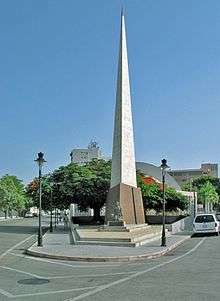Parque de la Abolición
| Parque de la Abolición | |
|---|---|
|
Parque de la Abolicion in Ponce, looking North | |
| Type | Urban park |
| Location | Ponce, Puerto Rico |
| Created | 1956 (renovated)[5] |
| Operated by | Government of the Municipality of Ponce, Puerto Rico |
| Open | 9 a.m. to 5 p.m. Entrance free. Closed on legal holidays, except for scheduled events. |
Parque de la Abolición (English: Abolition Park) is a city park in Ponce, Puerto Rico. It is the only park in the Caribbean dedicated to commemorating the abolition of slavery. It was established in the 1890s and renovated in 1956.
Location and features
The park is located on Avenida Hostos at the fork of Salud Street and Marina Street. The centerpiece of the park is a monument depicting a black male slave with broken chains depicting he is now a free man. A 100-foot high obelisk, Monumento a la abolición de la esclavitud, raises just behind the black iron sculpture of the freed slave that accentuates and gives instance to the occasion. The monument and obelisk are surrounded by graceful gardens. Immediately north of the obelisk is the outdoors acoustic amphitheater known as La Concha Acustica (English: The Acoustic Shell) which completes the park as a complete triangular city block. La Concha Acustica is an open-air auditorium used as a music venue, including presentations by the Ponce Municipal Band. La Concha Acustica can seat up to 2,000 people.[6] It was remodeled in 1956 by Francisco Porrata Doria, an architect from Ponce.[7][8]
Background
Slaves were brought to Puerto Rico from Africa from 1513 to the 18th century to replace the local Indian slaves who had been decimated.[9] The new slaves worked the coffee, sugar cane, and gold mining industries in Puerto Rico. During the 18th century, as gold mining ceased to be one of the major industries in Puerto Rico, slaves worked mostly in coffee plantations and sugar cane fields. By royal proclamation slavery was abolished on March 22, 1873.
History
In 1874, a year after the abolition of slavery, a group of citizens built a small park in memory of the historic event. In 1880 Olimpio Otero, Juan Mayoral Barnés, and Román Baldorioty de Castro were instrumental in creating the concept for a park dedicated to the commemorating the abolition of slavery, the only such memorial in the Caribbean.[10] Juan Mayoral Barnés brought the idea for the creation of the park to the Ponce Municipal Assembly on March 14, 1880. It was unanimously approved by the Assembly, and ratified by the Central Government, and confirmed by Royal Decree on March 1, 1881.[11] The park was built and opened in the 1890s. In 1956, under the administration of Ponce mayor Andrés Grillasca Salas, the statue of the freed slave was added at the base of the obelisk.[12] The sculpture of the freed slave is a work of Victor Colt.[13] Also in 1956, the park's Concha Acústica opened.[14]
See also
Further reading
- Ni la lluvia frenó al Ponce Jazz Fest. (By Reinaldo Millán. La Perla del Sur. Ponce, Puerto Rico. Year 30, Issue 1535. Page 26. 1 May 2013. Retrieved 1 May 2013.), photo of the Concha Acústica and its amphitheater sections of Abolition Park.
- Ni la lluvia frenó al Ponce Jazz Fest. Reinaldo Millán. La Perla del Sur. Ponce, Puerto Rico. Year 30, Issue 1535. Page 26. 1 May 2013. Accessed 2 June 2016. (Photo of the Concha Acústica and its amphitheater sections of Abolition Park.)
External links
References
- ↑ Tourist Attractions: Enjoy Ponce, Southern Experience. Brochure. Autonomous Municipality of Ponce. Office of Tourism Development. August 2010.
- ↑ Verdadera y Autentica Historia de la Ciudad de Ponce. By Dr. Eduardo Neumann. 1913. (In Spanish) Reprinted by the Instituto de Cultura Puertorriqueña (1987)Pages 99-100.
- ↑ Parque de la Abolición - Commemorating the End of an Era. NewMedia Holdings, Inc. Retrieved 26 February 2012.
- ↑ Parque y Obelisco de la abolición de la esclavitud y concha acústica. Ponce, Ciudad Señorial: Walking Tour. Government of the Autonomous Municipality of Ponce. Retrieved 26 February 2012.
- ↑ Ponce: Informacion para estudiantes. Government of the Autonomous Municipality of Ponce. Ponce, Puerto Rico. Retrieved 14 December 2011.
- ↑ Explore Puerto Rico. By Harry S. Pariser. San Francisco: Manatee Press. Page 244. Retrieved November 30, 2009.
- ↑ Brochure titled Tourist Attractions: Enjoy Ponce, Southern Experience. Autonomous Municipality of Ponce. Office of Tourism Development. August 2010.
- ↑ Recreacion. Oficina de Fomento Turístico. Municipio Autónomo de Ponce. 7 September 2009. Retrieved 5 February 2014.
- ↑ "Puerto Rico | Colonial Genocides | Genocide Studies Program". Yale University. Retrieved 2012-02-25.
- ↑ Parque de la Abolición - Commemorating the End of an Era. NewMedia Holdings, Inc. Retrieved 26 February 2012.
- ↑ Verdadera y Autentica Historia de la Ciudad de Ponce. By Dr. Eduardo Neumann. 1913. (In Spanish) Reprinted by the Instituto de Cultura Puertorriqueña (1987)Pages 99-100.
- ↑ Parque y Obelisco de la abolición de la esclavitud y concha acústica. Ponce, Ciudad Señorial: Walking Tour. Government of the Autonomous Municipality of Ponce. Retrieved 26 February 2012.
- ↑ Tourist Attractions: Enjoy Ponce, Southern Experience. Autonomous Municipality of Ponce. Office of Tourism Development. August 2010.
- ↑ Informacion sobre Ponce - Para Estudiantes. Ponce Municipal Government. Retrieved 1 April 2014.
Coordinates: 18°00′22.7874″N 66°36′45.7914″W / 18.006329833°N 66.612719833°W
